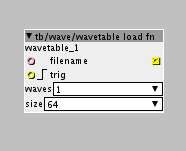Some random unfinished and unproven Sunday ideas for anti-aliased oscillators. They could be wrong, or not beneficial in practice, but maybe inspiring somehow?
representing the pre-integrated wave in integer can perfectly recover from overflow if the playback speed is limited, and avoid the need for double precision floating point. Ultimately floating point representation is not an advantage, only the number of mantissa bits matter. In floating point, the accuracy will drop towards the end of the table, while integer results in a constant accuracy.
the pre-integrated wavetable concept could also extend to a 2D (or 3D) summed area table
complex oscillator waveforms could be obtained from a set of octave-stacked DPW oscillators. A DPW oscillator only deviates at one single sample from the straight function (at the transition). When the phase difference of each oscillator is 180 degrees compared to the corresponding higher octave, there is really only a single transition at a frequency one octave higher than the top octave across all octave-stacked oscillators.
x.x.x.x.x.x.x.x.x.x.x.x.x.x.x.x.
.x...x...x...x...x...x...x...x..
...x.......x.......x.......x....
.......x...............x........
...............x................
This could lead to a massive reduction in computation. The tricky part is dealing with changing frequencies, jumping the top octave to the first below nyquist.noise shaping the oscillator period? When the period time is an integral number of samples, the alias frequencies align with the desired spectrum. Now that does not produce the desired frequency, but this could be seen as an application of noise-shaped quantization.
Cancelling aliases with another oscillator? Cancelling the first order aliases would already be a significant improvement. Perhaps an approximation could be created with an SSB frequency shifter?

 and i already plan all that...
and i already plan all that...  and i'd like to thank all its contributors
and i'd like to thank all its contributors 





